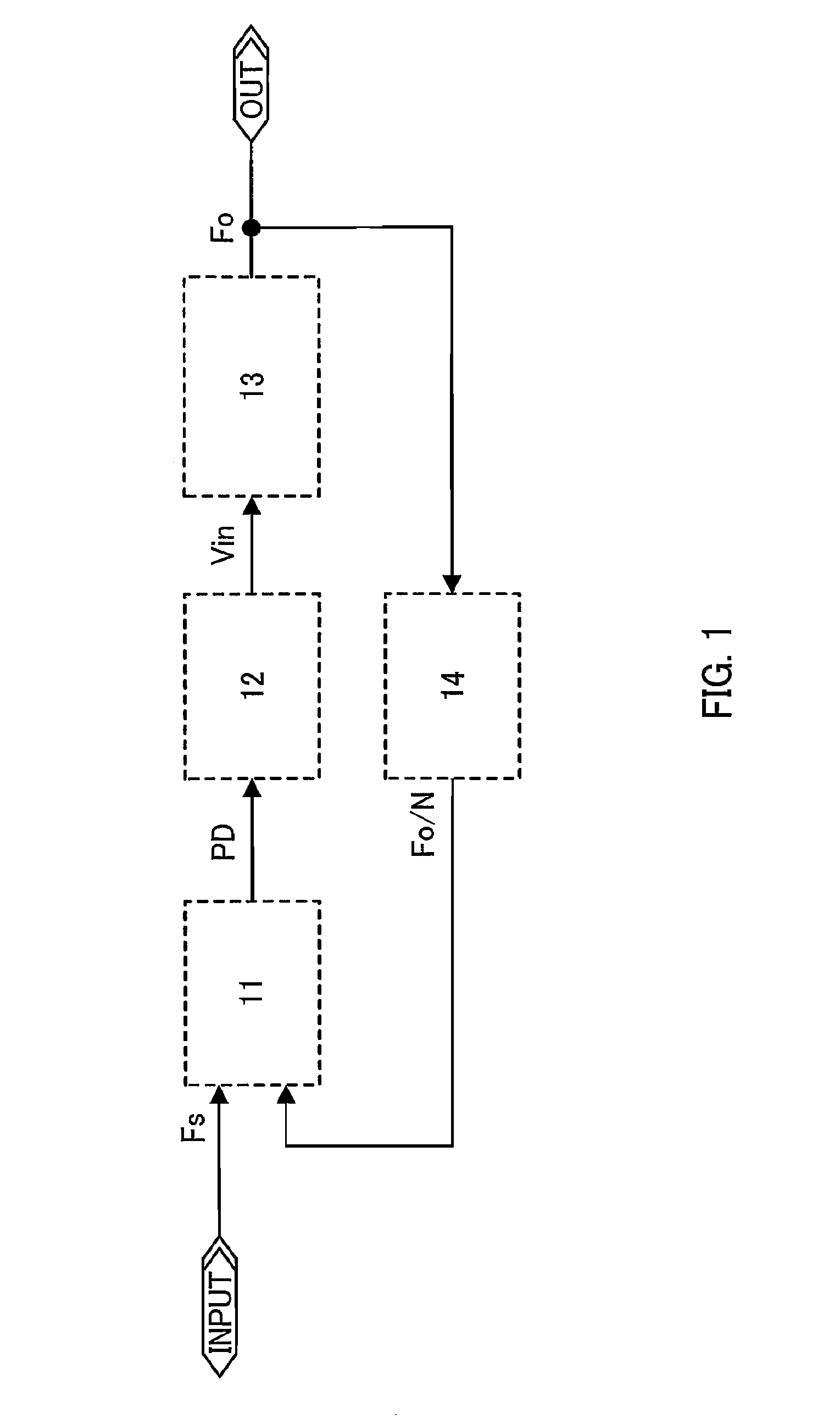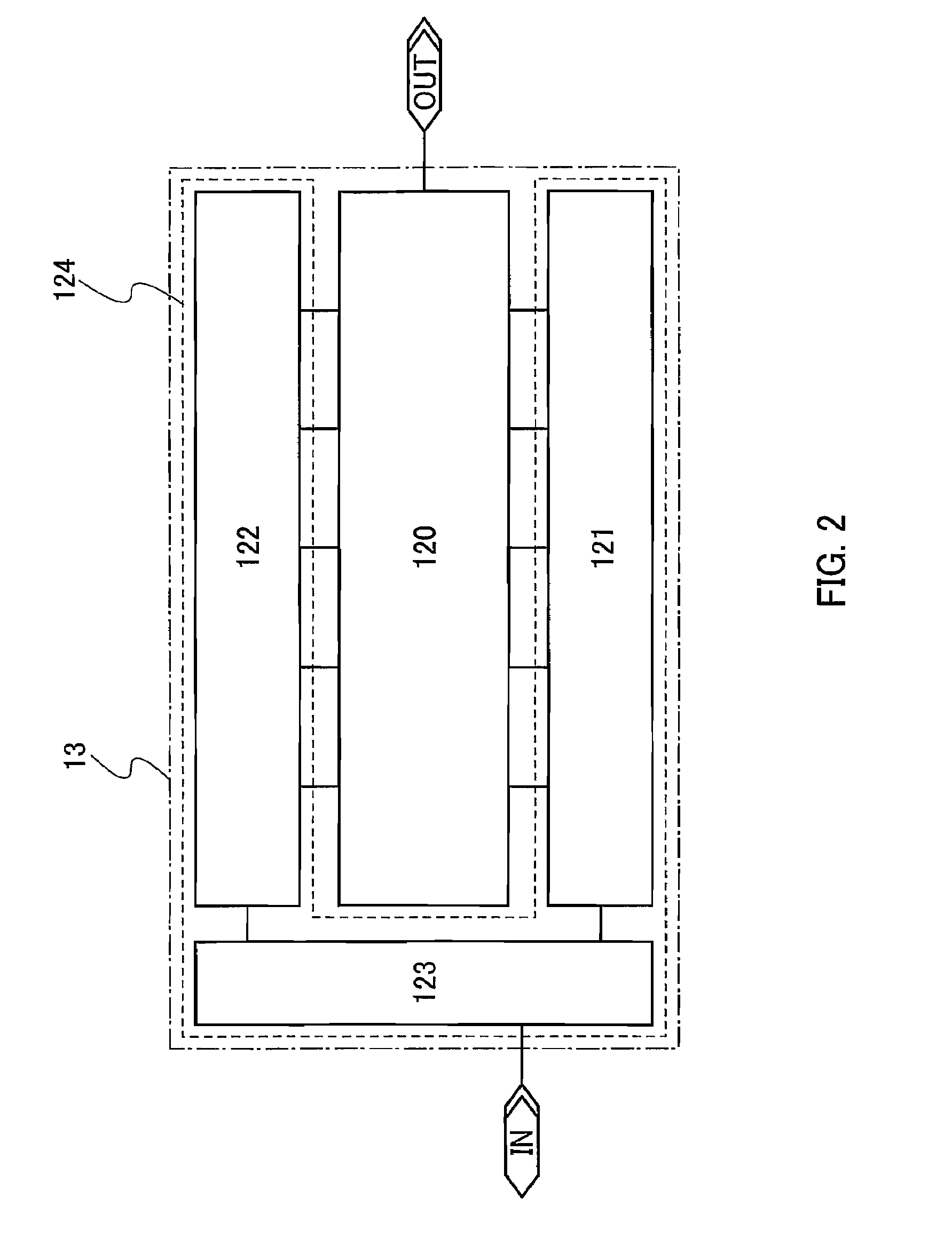PLL circuit and semiconductor device having the same
a technology of semiconductor devices and circuits, applied in the direction of pulse automatic control, pulse generation by logic circuits, pulse techniques, etc., can solve the problems of unstable input signal of vco, difficult to maintain stable control operation, unstable operation of pll circuits, etc., to achieve short lock time, short lock time, and longer lock time
- Summary
- Abstract
- Description
- Claims
- Application Information
AI Technical Summary
Benefits of technology
Problems solved by technology
Method used
Image
Examples
embodiment mode 1
[0030]FIG. 1 shows a block diagram of a PLL circuit in accordance with this embodiment mode. The PLL circuit includes a phase detector 11, a loop filter (LF)12, a voltage-controlled oscillator (VCO) 13, and a frequency divider 14. The phase detector 11 compares a phase of a signal Fs which is input from outside with a phase of a signal Fo / N which is input from the frequency divider 14. The loop filter 12 generates a signal Vin by removing alternating current components from a signal input from the phase detector 11. The voltage-controlled oscillator 13 outputs a signal Fo based on the signal Vin input from the loop filter 12. The frequency divider 14 converts the signal Fo output from the voltage-controlled oscillator 13 into Fo / N (frequency division by N), and outputs it to the phase detector 11.
[0031]Note that the PLL circuit in accordance with this embodiment mode is required to have at least the voltage-controlled oscillator 13. The phase detector 11, the loop filter 12, and the...
embodiment mode 2
[0054]In this embodiment mode, a configuration of a unit circuit 21 (exclusive OR circuit) of the phase detector 11 is described with reference to FIG. 7. The unit circuit 21 includes a NOR circuit 221 and transistors 222 to 227. In addition, the unit circuit 21 has two input terminals (indicated by 1 and 2 in FIG. 7), and one output terminal (indicated by 3 in FIG. 7).
[0055]This unit circuit 21 operates in the following manner. Upon input of the same signals to the input terminal 1 and the input terminal 2, an H-level signal is output from the output terminal 3. Upon input of different signals to the input terminal 1 and the input terminal 2, an L-level signal is output from the output terminal 3. That is, the unit circuit 21 compares a phase of a signal input to the input terminal 1 with a phase of a signal input to the input terminal 2, and outputs a signal from the output terminal 3 based on the result of the comparison.
[0056]Next, a configuration of a unit circuit 26 of the fre...
embodiment mode 3
[0059]FIG. 9 shows a configuration of a semiconductor device in accordance with this embodiment mode. This semiconductor device 300 includes an antenna 301, a modulation circuit 307, a rectifier circuit 302, a demodulation circuit 303, a signal processing circuit 306, a memory 305, and a PLL circuit 304. The PLL circuit 304 has a similar configuration to Embodiment Mode 1. Signals which are transmitted from a reader device to this semiconductor device 300 are received at the antenna 301. One of the signals is used for generating power in the rectifier circuit 302. Modulated signals are demodulated in the demodulation circuit 303, and the demodulated signals are input into the PLL circuit 304. Then, the PLL circuit 304 generates clocks in synchronization with the demodulated signals. The signal processing circuit 306 processes the demodulated signals by using the clocks, and then sends the processed signals back to the modulation circuit 307.
[0060]The semiconductor device 300 in acco...
PUM
 Login to View More
Login to View More Abstract
Description
Claims
Application Information
 Login to View More
Login to View More - R&D
- Intellectual Property
- Life Sciences
- Materials
- Tech Scout
- Unparalleled Data Quality
- Higher Quality Content
- 60% Fewer Hallucinations
Browse by: Latest US Patents, China's latest patents, Technical Efficacy Thesaurus, Application Domain, Technology Topic, Popular Technical Reports.
© 2025 PatSnap. All rights reserved.Legal|Privacy policy|Modern Slavery Act Transparency Statement|Sitemap|About US| Contact US: help@patsnap.com



